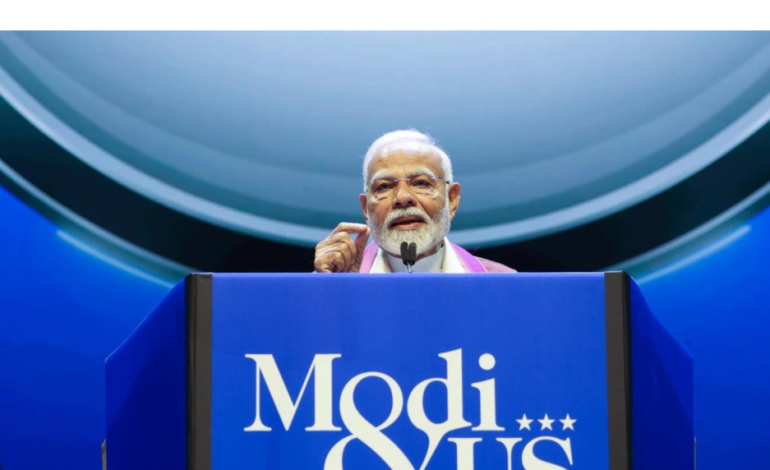
Celebration meets dissent: The polarizing impact of Modi’s U.S. tour.
- Dr.(h) Avi Verma, Publisher, IndoUS Tribune
Prime Minister Narendra Modi’s recent visit to the United States marked a moment of triumph and tension, encapsulating the contrasting emotions within the Indian diaspora. While the Nassau Veterans Memorial Coliseum in New York was filled with thousands of jubilant supporters celebrating India’s growing global stature, the streets outside echoed with the chants of protesters, highlighting the deep divides in opinion about Modi’s leadership.
On one hand, inside the Coliseum, more than 13,000 members of the Indian community from over 40 states gathered to witness a powerful display of cultural pride and political unity and on the other hand, hundreds of people gathered outside to showcase their dissent towards Modi’s governance.
Modi’s speech resonated deeply with his supporters, as he celebrated India’s progress on the global stage and acknowledged the crucial role of the diaspora in shaping India’s global perception. The Prime Minister introduced a new, symbolic interpretation of AI, stating, “For the world, AI means artificial intelligence, but for me, AI also means American-Indian spirit. This is the new ‘AI’ power of the world. I salute the Indian diaspora here.” His message was clear: the Indian-American community represents a bridge of strength, innovation, and unity, reflecting India’s values and aspirations.
Modi continued by praising the contributions of Indian Americans, calling them “Rashtradoot” (ambassadors of the nation). He said, “I have always understood the capabilities of the Indian diaspora. I understood it even when I held no official position. For me, you all have been strong brand ambassadors of India.” His words further invigorated the crowd, which erupted in applause, recognizing the acknowledgment of their influence and contributions to both India and their adopted homeland.
The event inside the Coliseum was a celebration of India’s achievements and its partnership with the United States. Modi highlighted India’s recent successes, from technological advancements to global leadership roles, while urging the diaspora to remain connected and involved in India’s journey of progress. His message was one of unity and collaboration, as he assured the Indian community that their efforts abroad are a vital part of India’s growing influence on the world stage.
However, while celebrations were in full swing inside the stadium, a very different scene was unfolding outside. Protesters, representing a diverse coalition of religious and human rights groups, gathered to voice their discontent over Modi’s policies and governance. Sikh, Muslim, Christian, and Dalit communities came together, accusing the Indian government of promoting religious intolerance, authoritarianism, and human rights abuses. The protests were loud and impassioned, with demonstrators holding banners, chanting slogans, and demanding accountability for what they perceive as Modi’s failure to protect India’s minorities.
One of the focal points of the protest was the Indian government’s handling of ongoing communal violence and repression, with special attention drawn to the revocation of Article 370 in Kashmir, the Citizenship Amendment Act (CAA), and the unrest in Manipur. Protesters held placards calling for justice, with many citing the 2002 Gujarat riots and accusing Modi’s administration of fostering an environment of division and fear. The protest was a stark reminder that, for many, Modi’s leadership represents deep-seated grievances that transcend borders and time.
As the protest unfolded, tensions between the celebratory atmosphere inside and the outrage outside became undeniable. While Modi’s supporters celebrated India’s rising global stature and the achievements of the diaspora, those outside reminded the world that significant sections of the Indian and global community remain deeply critical of Modi’s governance.
These protests reflect the complex and multifaceted nature of the Indian diaspora’s relationship with their homeland. For many, Modi represents a leader who has championed economic growth, technological progress, and national pride. Yet, for others, his leadership is synonymous with policies that have marginalized religious minorities and eroded democratic principles. This divide is not new, but the juxtaposition of the massive celebratory event and the passionate protests brought it to the forefront once again.
In conclusion, while Prime Minister Modi’s U.S. visit has undoubtedly solidified India’s position as a global power, it also highlighted the contrasting emotions that exist within the Indian diaspora. The celebrations inside the Nassau Coliseum demonstrated the pride and excitement of those who see India’s future as bright and promising. Yet, the protests outside served as a powerful reminder of the unresolved tensions and concerns about India’s current trajectory. As we reflect on this event, it is crucial to acknowledge both sides of the narrative — the triumphs as well as the challenges — that shape the identity and voice of the Indian diaspora today.